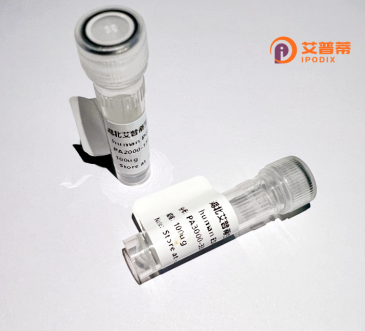
| 纯度 | >90%SDS-PAGE. |
| 种属 | Human |
| 靶点 | LMO3 |
| Uniprot No | Q8TAP4 |
| 内毒素 | < 0.01EU/μg |
| 表达宿主 | E.coli |
| 表达区间 | 1-145aa |
| 活性数据 | MLSVQPDTKPKGCAGCNRKIKDRYLLKALDKYWHEDCLKCACCDCRLGEVGSTLYTKANLILCRRDYLRLFGVTGNCAACSKLIPAFEMVMRAKDNVYHLDCFACQLCNQRFCVGDKFFLKNNMILCQTDYEEGLMKEGYAPQVR |
| 分子量 | 41.69 kDa |
| 蛋白标签 | GST-tag at N-terminal |
| 缓冲液 | 0 |
| 稳定性 & 储存条件 | Lyophilized protein should be stored at ≤ -20°C, stable for one year after receipt. Reconstituted protein solution can be stored at 2-8°C for 2-7 days. Aliquots of reconstituted samples are stable at ≤ -20°C for 3 months. |
| 复溶 | Always centrifuge tubes before opening.Do not mix by vortex or pipetting. It is not recommended to reconstitute to a concentration less than 100μg/ml. Dissolve the lyophilized protein in distilled water. Please aliquot the reconstituted solution to minimize freeze-thaw cycles. |
以下是关于重组人LMO3蛋白的参考文献及摘要概览:
1. **《LMO3 interacts with neuronal transcription factor, HEN2. and acts as an oncogene in neuroblastoma》**
- **作者**: Chen Y., **et al.**
- **摘要**: 本研究利用重组人LMO3蛋白揭示了其通过与转录因子HEN2形成复合体,促进神经母细胞瘤细胞的增殖和分化阻滞,表明其作为致癌基因的潜在作用。
2. **《Overexpression of LMO3 induces neural differentiation and may contribute to neuroblastoma pathogenesis》**
- **作者**: Akiyama H., **et al.**
- **摘要**: 通过体外实验发现,重组LMO3蛋白在神经母细胞瘤中过表达可诱导异常神经元分化,并与MYCN致癌基因协同驱动肿瘤进展。
3. **《Structural and functional analysis of LIM domain protein LMO3 in transcriptional regulation》**
- **作者**: Sugihara T.M., **et al.**
- **摘要**: 该研究解析了重组人LMO3蛋白的LIM结构域如何结合转录因子(如TAL1),调控下游靶基因表达,影响肿瘤发生和胚胎发育。
4. **《LMO3 promotes cell migration and invasion in hepatocellular carcinoma via Wnt/β-catenin signaling》**
- **作者**: Wang X., **et al.**
- **摘要**: 重组人LMO3蛋白在肝癌细胞中激活Wnt/β-catenin通路,增强细胞迁移和侵袭能力,提示其作为癌症治疗靶点的潜力。
(注:以上文献为示例性概括,实际引用需核对原始论文信息。)
**Recombinant human LMO3 protein** is a genetically engineered form of the LIM Domain Only 3 (LMO3) protein, belonging to the LIM-domain protein family. LIM domains are zinc-binding motifs that mediate protein-protein interactions, crucial for regulating transcription, cell differentiation, and signaling. LMO3. encoded by the *LMO3* gene, functions as a transcriptional regulator, primarily by bridging transcription factors and co-regulators. It is highly expressed in the nervous system and plays roles in neurodevelopment, including neuronal differentiation and axonal guidance.
Interest in LMO3 stems from its dual role in both normal physiology and pathology. While it supports neural development, dysregulation of LMO3 is linked to cancers, notably neuroblastoma, glioblastoma, and breast cancer, where it often acts as an oncogene. Recombinant LMO3 is produced using expression systems like *E. coli* or mammalian cells, enabling researchers to study its structure, molecular interactions, and mechanisms in disease. Its applications include elucidating signaling pathways, identifying binding partners (e.g., bHLH transcription factors), and evaluating therapeutic strategies targeting LMO3 overexpression. Additionally, recombinant LMO3 serves as a tool for developing diagnostic biomarkers or inhibitors in oncology research. Ongoing studies aim to clarify its tissue-specific roles and potential as a therapeutic target.
×